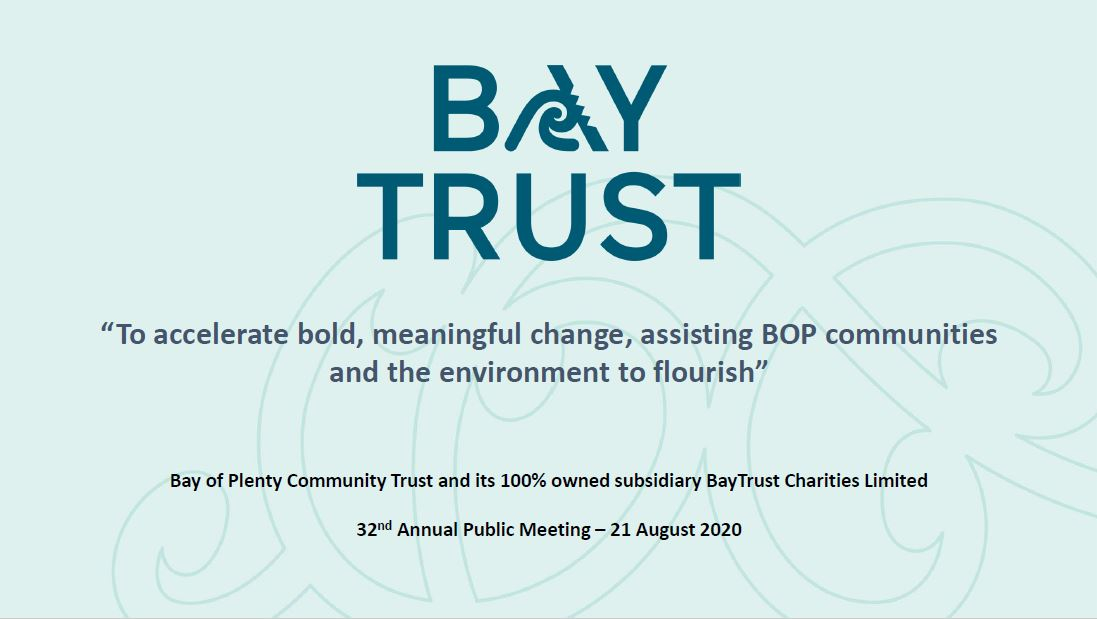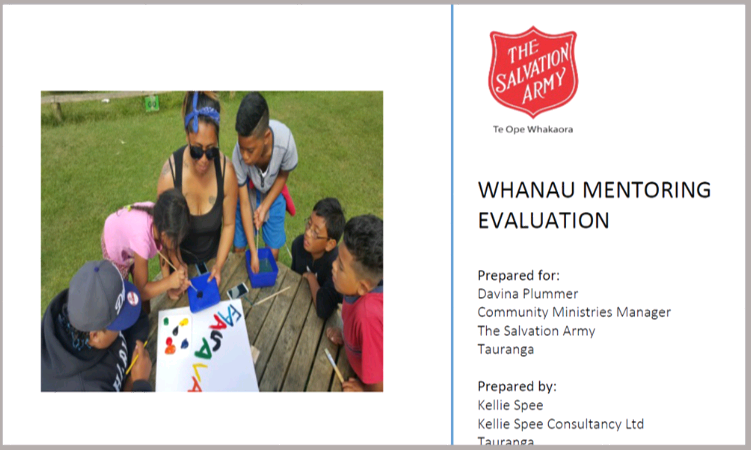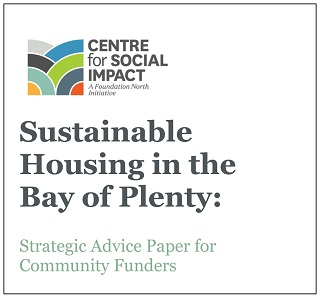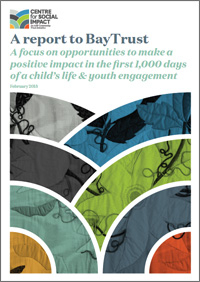Research & Publications
BayTrust 2020 Annual Public Meeting Presentation
Click below to download and read

Evaluation of the Salvation Army Mentoring project
Click below to download and read

Sustainable Housing in the Bay of Plenty
Click below to download and read:

Research Project: Investing For Social Impact in the Bay of Plenty

A major research project into how best to support Bay of Plenty children in the first 1000 days of their lives, and how to engage youth in the region, has identified significant opportunities for BayTrust to invest strategically for the region’s future success.
“BayTrust provides around $2 million in grants to a wide range of community initiatives each year,” the Trust’s Community Development Advisor, Terri Eggleton, says. “We want to make sure that our grants go to where they will have the greatest impact to help us build, strengthen and enhance our region’s communities.”
“Our strategic plan identified the first 1000 days and youth engagement as focus areas where investment by the Trust could make a difference. What we needed was quality information on where investment would have the biggest social impact.”
BayTrust, in partnership with the Ministry of Social Development and the Community Response Forum, commissioned research to identify opportunities. The research project combined local knowledge of what was happening for children and youth in the region with an expert review of national and international research on successful first 1000 days and youth engagement initiatives.
“There are many community leaders and organisations in our region doing great work with families and young people. They were invited to contribute to the project and we were delighted with the very enthusiastic response,” Terri Eggleton says. “Everyone was keen to contribute to help us understand where we could make a difference, where services could be improved, and where there were opportunities for collaboration.”
The research was carried out by the Centre for Social Impact, founded by the ASB Community Trust.
“It was an advantage to us to be able to commission this work from the Centre for Social Impact. The Centre draws on the years of experience ASB Community Trust has, as Australasia’s largest philanthropic funder, of strategic investment in innovative community initiatives. This meant that they were able to understand what we needed, were in touch with what is happening nationally and internationally, and could provide us with an outcome that was really relevant to our needs.”
BayTrust, the Ministry of Social Development and the Community Forum are now considering how they will take the recommendations from the research forward.
“We have a wealth of information and insight. The challenge now is to put this into action, starting with sharing the reports with all the people and organisations in the community who contributed to this important work. We want their feedback on what the report has identified and their thoughts on priorities for action.”
Download the individual reports:
- Summary and Recommendations (1.6MB .pdf)
- Opportunities For First 1000 Days (2.2MB .pdf)
- Positive Outcomes and Futures For Youth (1.3MB .pdf)
- Community Consultation Hui (14.4MB .pdf)
- Survey Details (2.0MB .pdf)
For further information please contact:
- Terri Eggleton
- Bay Trust Community Development Advisor
- 07 928 1861
Investment for social impact in the Bay of Plenty
In undertaking this exploratory work with the Centre for Social Impact, BayTrust wanted to identify opportunities for:
- strategic investment in supporting youth engagement and opportunities to make a positive impact in the first 1,000 days of a child’s life. BayTrust has opportunities to provide traditional philanthropic funding as well as to be a funder using emergent models of funding (e.g. catalytic or venture philanthropy). Funding is also undertaken alongside opportunities for capacity building, collaboration, and knowledge brokering
- working in partnership with other local and national organisations that are also interested in early years and youth priorities. This work was undertaken in close collaboration with the Ministry of Social Development. New or extended opportunities for collaboration may be useful to consider. It is also important not to duplicate services that may be funded or supported by other sources, including government funding
- effective and strategic responses to projected population changes, needs, strengths and challenges. Regional population transitions and changing population age structures will have an impact on the communities served by BayTrust.
A snapshot of our region
- Census 2013 data states that a total of 21,588 children under 5 years and 36,738 youth aged 15 to 24 years live in these districts. The proportion of Māori children and young people varies across the region. In Western Bay of Plenty, around one third of children and a quarter of the young people are Māori. In Eastern Bay of Plenty, this proportion more or less doubles, with 61% of children and 57% of young people being Māori . Rotorua has the highest number of children and young people in the region, with approximately half being Māori.
- Compared to New Zealand as a whole, the BayTrust geographic area includes a higher proportion of high deprivation areas and a lower proportion of low deprivation areas. However, it is important to note that there are variations in deprivation across the BayTrust region. Similarly, although there is variation across geographic areas, overall the median income across the BayTrust area is lower for all people and for Māori than are the median income levels for all New Zealand and for all Māori.
Overview of priority areas
- The first 1,000 days includes the period of pre-pregnancy and birth; infancy (birth to the first six months); and toddlerhood (six months to two years). Combined, these developmental periods build the foundation for a child’s ability to grow, learn and thrive.
- Youth generally refers to young people aged 15 to 24 years. Youth marks the period of transition from childhood to adult independence, and can include significant points of change such as leaving school education, transition to other education, employment or training, and/or to parenthood. While some young people navigate smooth transitions to adulthood, other young people experience transitions that place them at increased risk of social exclusion, deprivation and negative life outcomes.
- The risks faced by vulnerable youth and by vulnerable families in the first 1,000 days of a child’s life are complex. As such, the provision of effective youth engagement, and effective support to make a positive impact in the first 1,000 days, cannot be the sole responsibility of a single agency or organisation. There is national and international recognition that solutions need to be multifaceted and acknowledge the complementary roles of government agencies, philanthropic organisations, and community organisations.
Major opportunities identified for the Bay of Plenty
First 1000 days
What does the research identify?
- When babies grow up in impoverished, abusive, neglectful and/or punitive environments, they are more likely to carry a significant burden (socially, physically and economically) and thus never reach their full potential.
- When these early experiences and environments are enriching, supportive and positive, the majority of babies grow up well and go on to become positive contributing members of society, who feel loved, valued and a part of healthy whānau.
- First 1000 days recommendations for the Bay of Plenty
- Upskill existing community workers in the importance of the first 1,000 days, so that those already engaged in vulnerable communities can widen their own understandings and support the dissemination of information and education.
- Prioritise intervening early, using the best available evidence, in the lives of mothers/families who face the “clusters” of challenges that make them the most vulnerable (e.g. age/education, housing, stressors). This must include practical solutions to practical problems, such as evidence-based parenting programmes which provide transport of the parent and child to co-related programmes.
- Support the development of “baby friendly” environments (e.g. with areas to feed infants, and prioritised parking spaces) that are also welcoming and engaging to young parents, including through the use of technology and support for web-based learning services.
Youth engagement
What does the research identify?
- Historically, much of the emphasis in youth programmes and solutions designed for youth has been on personal responsibility—“youth need to drink less, study harder and get a better attitude”.
- While personal responsibility is important, evidence suggests that as youth grow and develop, their ability to make decisions is highly dependent on their context, experiences, peers, family, community influences, and opportunities. Most of the programmes that are successful for youth take a wider youth development and ecosystem approach because they acknowledge that an individual’s behaviours and positive outcomes are shaped by many factors in their environment.
Youth engagement recommendations for the Bay of Plenty
- Support multi-component leadership programmes that have a positive youth development, academic and future goal-orientated emphasis with strong cultural components.
- Support programmes for youth that provide opportunities to contribute to society and learn important employment, business and networking skills.
- Build partnerships with local authorities, government and iwi to develop child and youth friendly policies as a basis for creating liveable and vibrant communities for children and young people to thrive and succeed.





